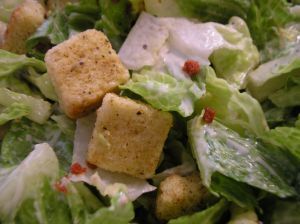Hail Caesar ! While many people think that the wildly popular menu staple Caesar salad is named after the Roman emperor Julius Caesar, it is, in fact, named for an Italian chef and restaureteur from Tijuana, Mexico. The generally accepted and well- documented origin of the dish stretches back to 1924, when a sudden rush of customers one night at Caesar Cardini’s Tijuana restaurant, caused him to toss together a salad made of what he could gather from the kitchen. This he did in view of the diners at tableside. To this day, tableside preparation of the salad is a “must see” tradition upheld at many fine- dining establishments.
Until recent years, Caesar salad was a special dish usually reserved for fine- dining menus. But now, it has gone mainstream. Most casual restaurants and fast food chains now offer some variation on the theme. A Caesar salad used to be prepared essentially the same way, anywhere you went, across the board. Some torn romaine lettuce leaves and croutons, tossed in a heavy, anchovy- based beige dressing topped with grated parmesan cheese. While for the most part, Caesar salad remains true to its origins at many restaurants, it has also become the launching pad for many creative chefs’ whims and experiments. Recently, as a working chef, I have seen or prepared, per menu- specifications, Caesar salads adorned with diced tomatoes, sliced red onions, diced red peppers, pepperoncini and even orange slices.
Most line cooks and chefs have a strong background in salads, before they get to start cooking, myself being no exception. I was taught how to prepare Caesar salad by the chef/ owner of a small breakfast/ lunch restaurant in Manchester, Connecticut. Prior to opening his own business, he worked ten years at a four- star restaurant, where he was trained in the classic preparation of Caesar salad. Although many cookbooks will call for tearing of the romaine leaves, I prefer to cut the lettuce into a large dice, or bite- size pieces, with a stainless steel knife, to prevent ‘rusting. Before cutting or tearing the romaine, it must first be washed thoroughly. Romaine has a tendency to contain much sand and grit inside its leaves. Once the romaine has been washed, lay it flat and cut off the whitish ends( approximately 1 1/ 2 inches.) Be selective in choosing which leaves to use. Usually, the outer leaves are unusable. Safely, cut or tear the leaves in a large dice- pattern, to produce roughly 1 inch pieces. While there are no absolute requirements concerning which ingredients to toss in the dressing, the following method is one I have used in several restaurants. You may however, prefer to toss the ingredients ‘dry’, then add dressing separately. The following method is designed to provide two to three servings.
In a large bowl, combine four cups chopped romaine pieces, 1 / 2 cup of croutons and 1/ 2 cup of grated parmesan cheese and 1/ 2 cup of Caesar dressing. Do not ‘over-dress’. Using your gloved hand, or utensil of your choice, gently toss and roll the salad from the bottom up. Treat the leaves with care. When the ingredients are evenly coated with dressing, place them in a chilled serving bowl or on a dish, gently cascading the leaves in a tangle, or pile. Garnish with additional croutons, or parmesan cheese, if desired. For added flavor and color, the addition of diced tomatoes or red peppers is encouraged.
Now, on to the dressing. My advice might surprise some readers, coming from a trained chef, but I have maintained for years that it is not usually cost, or time- effective for restaurants to produce their own Caesar dressing. The same holds true for home cooks. Because of the wide variety of bottled and fresh dressings, both creamy and oil- based, available in grocery stores today, the convenience, as well as the taste, is hard to beat. If however, the intrepid home cook would like to create a from- scratch version of the classic dressing, I offer the following example, which is a pretty standard variation of the recipe. Paired with grilled chicken, shrimp or lobster, and some crusty bread and butter, Caesar salad offers a light, refreshing meal for any occasion. ENJOY !
Caesar Salad Dressing
1 small flat, or can of anchovies
2 large cloves garlic
1 Tablespoon Dijon mustard
1/ 4 cup of lemon juice
1 teaspoon of worcestershire sauce
1/ 4 cup egg substitute
3/ 4 cup- 1 cup vegetable oil
Puree anchovies and garlic in food processor. Add all other ingredients, except oil. Mix well. With food processor running at low speed, add oil in a thim, stesdy stream, until well blended. Store up to one week in refrigerator.




